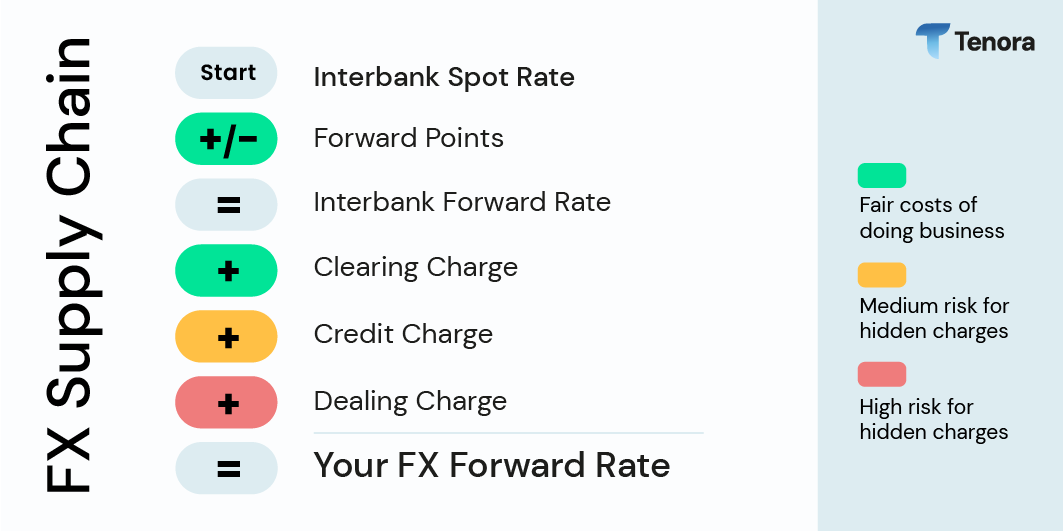Think your FX forward rate is just a number? It’s actually the product of a multi-step supply chain—with markups and hidden costs at every stage. This guide breaks it down and shows how transparency can lead to better pricing and better partnerships.

When you execute an FX forward contract, you’re locking in a rate for a future currency exchange. But how is that rate actually built?
Most clients only ever see the final rate on the screen or term sheet. They rarely get visibility into the building blocks of that price, or the cost layers silently baked in. The truth is, your FX forward rate is the output of a supply chain. And like any supply chain, each link comes with its own cost… and its own opportunity for mark-up.
Understanding the FX rate supply chain is the first step toward fairer pricing, smarter decisions, and more trusted relationships.
Here’s how your rate is typically constructed behind the scenes:
Interbank Spot Rate
+ / – Forward Points
= Interbank Forward Rate
+ Clearing Charge
+ Credit Charges
+ Dealing Charges
= Your FX Forward Rate
Each of these layers plays a role in shaping the final price you’re quoted—but most clients never get to see them.
Let’s look at each layer and see where the hidden costs live.
This is the live market price of a currency pair, as seen on global trading platforms. It’s determined by real-time supply and demand and is the foundational base for every FX forward rate.
Forward points reflect the interest rate differential between the two currencies and are added or subtracted from the spot rate to form the interbank forward rate. This is purely a market convention that does not directly generate revenue for your counterparty.
This is the “raw” forward rate before any counterparty-specific charges are added.
From here, we start adding layers—this is where costs (both legitimate and hidden) enter the equation.
Your counterparty (e.g. broker) typically doesn’t hold the risk of your forward trade—they will create an equal transaction with their liquidity provider in order to acquire the funds they will ultimately send you. Their liquidity provider will charge for this transaction, and your counterparty will pass this charge onto you.
This is strictly an operational requirement, with no real scope for you to influence this cost.
If you don’t post margin, your counterparty is effectively extending you credit for the duration of the forward contract. They may need to post collateral with their liquidity provider in order to acquire your funds, typically without earning interest on it.
The cost of this credit is computed like interest on a loan—based on notional size, tenor, and your counterparty’s internally-derived funding rates.
If you post initial margin or collateral, this credit cost should be reduced. That benefit should flow through to your rate.
❗ Hidden cost alert: Some providers apply a steep or inconsistent markup on this cost, often hard to detect without transparency. It can be thought of as being charged a borrowing rate well in excess of what your creditworthiness suggests is fair.
This is the broker’s profit layer. It covers their operating costs and is where they apply their own markup to the trade.
This is the most discretionary part of the supply chain. It can be consistent—or vary dramatically from one trade to the next.
❗ Hidden cost alert: Without a fixed dealing charge or visibility into how it’s calculated, this is where clients often overpay. Your dealer may being your relationship charging a low markup, but increase it at their discretion on a trade-by-trade basis based on whatever they believe they can get away with.
This is the final rate you’re quoted. It’s the output of a chain of market inputs, legitimate operational costs, and (potentially excessive) markups.
The problem? Most clients never see the chain. They only see the end result.
When pricing is opaque, clients are forced to fall back on short-term tactics—comparing quotes, playing providers off against each other, and treating every trade as a negotiation. This creates a transactional mindset that undermines trust and weakens the potential for long-term collaboration.
But transparency flips that dynamic.
When a counterparty openly breaks down how your FX forward rate is constructed—spot, forward points, clearing, credit, dealing—it creates the foundation for a more strategic relationship. Clients gain clarity and confidence, and providers shift their focus from margin-per-trade to delivering better risk outcomes, consistent pricing, and long-term value.
Transparency transforms the relationship—from profit-driven trades to outcome-driven collaboration. It’s no longer about winning on one trade—it’s about winning together, over time.
We built the tool we believe every business deserves. The Hedge Analyser gives you a clear breakdown of your live and executed hedge costs—empowering more open, informed conversations with your broker. There’s no cost and no login required—because we believe transparency should be a shared standard, not a gated feature.
Alongside the right tools, it's powerful to ask consistent, informed questions that show you're serious about pricing fairness and long-term value:
Asking these questions signals that you're informed, serious, and unwilling to accept opaque pricing. You may also sense that your dealer is on the back foot and not wanting to provide direct answers. We believe you deserve better.
The FX forward rate isn’t magic—it’s a sequence of logical inputs and markups. When you understand the chain, you can challenge it, benchmark it, and improve it.
If you’d like help analysing your current forward pricing—or want to benchmark your costs against market standards—we’re here to help.
Let’s make transparency the new standard.